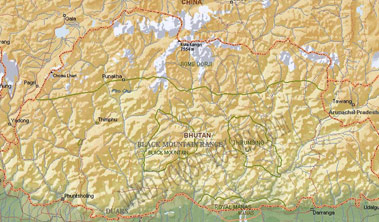The Traditional Medicine
One of the ancient names for Bhutan was Menjung
– ‘the Land of Medicinal Herbs’.
The Himalayan
medicine is called So-ba Rig-pa
and is practised in many countries today. Because
it originally developed in ancient region, it is
commonly known as Himalayan medicine.
 It is believed that at the beginning of time,
the art of healing was a prerogative of the gods.
It wasn't until Kashiraja Dewadas, an ancient
Indian king, went to heaven to learn medicine that
medicine could be offered to humans as a means to
fight suffering. He taught the principles and the
practice of healing, and this knowledge was spread
as part of early Buddhist sacred writings.
It is believed that at the beginning of time,
the art of healing was a prerogative of the gods.
It wasn't until Kashiraja Dewadas, an ancient
Indian king, went to heaven to learn medicine that
medicine could be offered to humans as a means to
fight suffering. He taught the principles and the
practice of healing, and this knowledge was spread
as part of early Buddhist sacred writings.
From the
seventh century, some of these medicinal texts
were translated into Tibetan and the rulers became
interested in the subject. From that time, So-ba
Rig-pa was considered a single system of medicine,
although some differences are found in the
different lineages based on the discovery of
terma, which occasionally include medicinal
teachings.
When Shabdrung Ngawang Namgyal came to Bhutan,
his minister of religion, Tenzin Drukey, an
esteemed physician, spread the teaching of So-ba
Rig-pa. Today, the
Himalayan tradition is the most common
type of medicine practised in Bhutan. It has been
recognised by the government as the official
medical tradition of the country and has been
included in the national health system since
1967.
Therapeutic Practices
Several forms of treatment are applied in
traditional medicine. Hundreds of medicinal
plants, minerals and animal parts form the basic
drugs used by the practitioners. These ingredients
are processed and mixed in different combinations
to make about 300 medicines in the form of pills,
tablets, syrups, powders and lotions. Other
treatments include dietary and behavioural advice.
There are also so-called surgical procedures that
include gtar (blood letting), bsregs
(cauterisation by lerbal compounds), gser facos
(acupuncture by a golden needle), tshug
(cauterisation with instruments of different
materials), dugs (applying heat or cold to parts
of the body), byugs-pa (medicated oil massage),
sman-chu (stone-heated bath), fsha-chu (bath at a
hot spring) and turn (vapour treatment).
Diagnostic Techniques
Diagnosis begins with an examination of the 12
pulses, the tongue and urine, and questions to the
patient. Illnesses develop with the increase,
decrease or destabilization caused by bad food,
the weather, evil spirits, the weight of
previous actions, karma, or way of life.
Remedies, in general, consist of a diet that
varies with the nature of the illness, and
medicines, which may be aided by acupuncture
and moxibustion.
The decision about what kind of treatment to
use for a particular condition is made by the
physician mainly through the reading of the
pulses. In modern medicine, pulse reading is only
used to detect anomalies of the heart and of the
circulatory system. Using the So-bar Rig-pa
method, it is possible to detect diseases of any
organ through the pulses. The eyes, tongue and
urine are also examined for signs that will help
with the diagnosis, and sometimes the physician
will record the patient's medical history.
Importance of Traditional
Medicine
Traditional medicine has always been regarded
as important in Bhutan, and a dispensary which
doubles as a training centre was opened at
Dechenchoeling in 1967. In 1979, a traditional
medical hospital with a laboratory for making
medicines was opened in Thimphu, subsidized by the
World Health Organization. This hospital can be
visited. Four dispensaries were
also set up in the rest of the country. In 1988, a
project for cataloguing plants and establishing a
training centre for doctors was begun with the
help of an Italian non-governmental
organization. This project today is being
continued by European Community. |